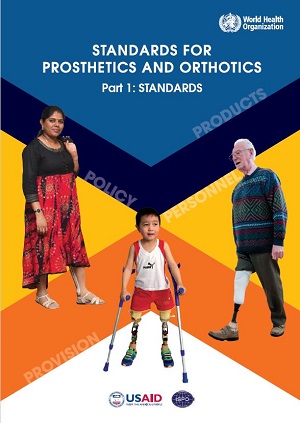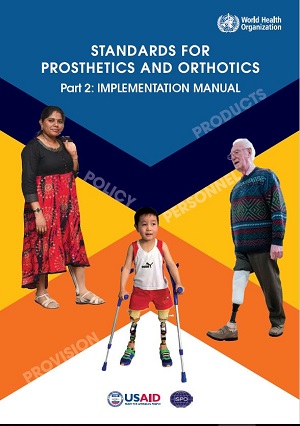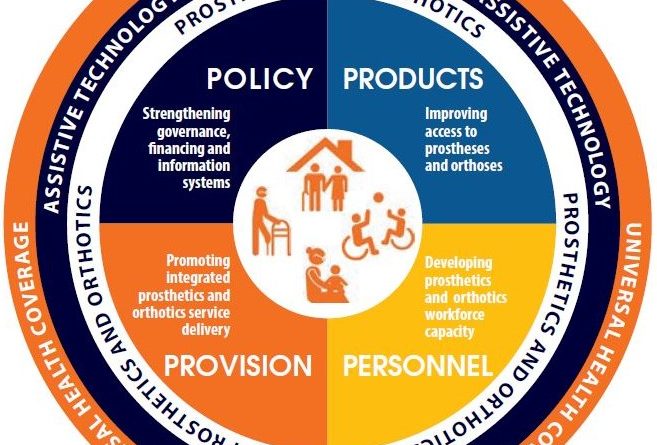Announcing 60 Standards for Prosthetics and Orthotics
The World Health Organization has published new Standards for Prosthetics and Orthotics. They are published in 2 parts (Part 1 Standards and Part 2 Implementation Manual). Its aim is to ensure that prosthetics and orthotics services are people-centred and responsive to every individual’s personal and environmental needs.
There are 60 standards in 4 areas (Policy, Products, Personnel and Provision).
We have reproduced the summary of the standards below:
“Area 1. Policy
Leadership and governance
STAKEHOLDERS AND COORDINATION
1 Governments should assume a leading role in the development and coordination of national prosthetics and orthotics service provision.
2 Governments should involve all relevant stakeholders – including service users, caregivers and user groups – in policy development, planning, implementation, monitoring and evaluating prosthetics and orthotics services.
3 A national prosthetics and orthotics committee or similar entity, with a wide range of stakeholders, should be in place for the coordination and development of national prosthetics and orthotics service provision.
GUIDING FRAMEWORK FOR PROSTHETICS AND ORTHOTICS SERVICE PROVISION
4 There should be a national guiding framework for prosthetics and orthotics service provision.
5 Prosthetics and orthotics service provision should be regulated by the State.
MONITORING
6 Prosthetics and orthotics service should be monitored nationally and regionally.
INTERNATIONAL COORDINATION AND COOPERATION
7 Governments and national stakeholders should collaborate internationally and share experience, data and research on prosthetics and orthotics service provision.
INTERNATIONAL SUPPORT
8 International support, when provided, should contribute to the establishment and implementation of national prosthetics and orthotics policies and strategic plans and be aligned with the provision system of the national health and welfare service.
Financing
ECONOMIC ANALYSIS OF PROSTHETICS AND ORTHOTICS SERVICE PROVISION
9 The cost of providing prosthetics and orthotics services should be assessed periodically.
10 The direct and indirect economic benefits of prosthetics and orthotics services should be analysed at individual, family, community, society, health sector and national levels.
FUNDING PROSTHETICS AND ORTHOTICS SERVICES
11 Prosthetics and orthotics services should be an integral part of universal health coverage.
12 Prosthetics and orthotics services should be included in national health and social insurance systems, like other health interventions.
Information
13 Data on prosthetics and orthotics service provision should be collected periodically, analysed at service level and shared at national level.
14 A national prosthetics and orthotics database should be established to identify total need, types of need and unmet need.
Promotion of prosthetics and orthotics service
15 Strategies for raising awareness about prosthetics and orthotics services should be established, including rights-based, social and economic arguments.
Area 2. Products
Types
16 An appropriate range of prosthetic and orthotic products should be available in countries to suit local needs and realities.
17 A national list of priority prosthetic and orthotic products should be drawn up, respected and updated regularly.
18 International standards should be used for national classification of prosthetic and orthotic products.
Supply of materials
19 Components, materials, consumables, tools, machines and other equipment used exclusively for fabrication of prosthetic and orthotic products that are not available in a country should be exempt from import duty and customs fees.
20 Reuse of prosthetic and orthotic components should be regulated by a designated authority or group of experts with no conflict of interests and involve proper quality control and documentation.
Technical standards
21 National regulation of prosthetic and orthotic products, components and materials should be an integral part of the national health care regulatory system.
22 Prosthetic and orthotic products should be tested structurally for compliance with ISO or equivalent standards before being sold on the market.
Research and development
23 Clinical and technical research should be conducted in prosthetics and orthotics, and the results should be shared nationally and globally.
24 Affordable prosthetic and orthotic products that are cost–effective, of good quality and context-appropriate should be developed and made widely available.
Area 3. Personnel
Personnel who provide prosthetics and orthotics services
25 Prosthetics and orthotics services should be provided by competent, adequately trained professionals.
26 Complicated prosthetics and orthotics treatment and care of complex cases should be provided by a multidisciplinary team of professionals with complementary skills.
Training in prosthetics and orthotics services
CORE PERSONNEL
27 Training in prosthetics and orthotics should be aligned with national and international educational standards.
28 Training in prosthetics and orthotics should be available at various levels to fully meet national needs.
OTHER PERSONNEL
29 Health care professionals, especially rehabilitation professionals, who provide treatment relevant to prosthetics and orthotics services should have adequate knowledge about prosthetics and orthotics.
CONTINUING PROFESSIONAL DEVELOPMENT
30 Continuing professional development should be compulsory in prosthetics and orthotics professional practice.
Planning the prosthetics and orthotics workforce
31 Workforce planning should take into account all the disciplines required in prosthetics and orthotics services at all levels.
32 Prosthetics and orthotics service units should have at least one prosthetist and orthotist to supervise and guide clinical and technical work.
33 A strategy to retain prosthetics and orthotics personnel should be in place.
Professional regulation and recognition
34 Prosthetics and orthotics clinicians should be regulated by the State within regulations for health professionals.
35 Prosthetists and orthotists should assume responsibility for services provided by associate and nonclinical personnel under their supervision.
36 Prosthetics and orthotics personnel should have a clear career structure and employment conditions that are aligned with those of other health care professionals, associates and technical personnel.
Area 4. Provision of services
User-centred service delivery
37 A documented policy to safeguard the rights of users of prosthetics and orthotics services should be in place and in effect, outlining the features of user-centred services.
38 Service users and their representatives should be involved in policy-making, planning, implementing, monitoring and evaluating prosthetics and orthotics services, take part in decision-making at all levels and be represented on relevant committees.
39 Service users should be given the opportunity to choose their service provider and technology, including components and materials, according to their need, among the options available in the country and the limits set for financing or reimbursement.
Systems for delivering services
INCLUSIVE SERVICE DELIVERY
40 Prosthetics and orthotics services should be accessible to all the people who need them: girls, boys, women, men and older adults.
41 Prosthetics and orthotics services should be part of the health sector or be closely linked to it.
42 Prosthetics and orthotics services should be delivered in a three-tier system, at primary, secondary and tertiary levels, with established links and two-way pathways for referral and follow-up.
43 Maintenance and repair services should be an integral part of a prosthetics and orthotics service delivery system.
INCLUSIVE SERVICE DELIVERY IN DISASTER CONTEXTS
44 The provision of prostheses and orthoses in disaster conditions should be an integral part of the health sector response and be planned to ensure a seamless transition to long-term service provision.
Service units
SETTING
45 Prosthetics and orthotics service units should be established within or closely linked to health and rehabilitation service facilities, such as district and referral hospitals.
46 The possibility of integrating prosthetics and orthotics service units into broader services for assistive products should be considered and explored.
INFRASTRUCTURE
47 At all service levels, prosthetics and orthotics units should be designed to ensure effective, efficient, high-quality service provision in a user-friendly, barrier-free, safe clinical environment.
EQUIPMENT
48 Prosthetics and orthotics service providers should define and adhere to a plan for equipment maintenance and replacement.
SAFETY
49 The safety of service providers and users should be ensured by the establishment of documented health and safety regulations.
Service unit processes
THE SERVICE DELIVERY PROCESS
Identification and referral
50 Prosthetics and orthotics service providers should identify and train partners in identifying and referring potential users.
Service delivery
51 All steps in the delivery of prosthetics and orthotics services should be based on the best available evidence and should adhere to local, national and international standards and practice.
Assessment
52 Service providers should involve service users and caregivers in assessment, setting goals and planning treatment.
53 Peer support and counselling should be available to service users as appropriate.
Fabrication and fitting
54 Prosthetics and orthotics personnel should follow the instructions and guidelines of the component manufacturer and document any deviation from standard practice.
User training
55 Service users should be given sufficient training to ensure safe, effective use of prostheses and orthoses. Family members and caregivers should be involved as appropriate.
Product delivery and follow-up
56 Users or caregivers should make the final decision about the acceptability of the fit and function of the prosthesis or orthosis.
57 The outcome of prosthetics and orthotics treatment should be evaluated and documented.
58 Prosthetics and orthotics service users should be followed up regularly.
MANAGEMENT
59 Annual and long-term strategic and operational plans should be in place, with performance indicators for continuous monitoring.
60 The required quality should be defined and adhered to at all levels and in all parts of the prosthetics and orthotics service delivery system”.
===
The above standards are summarised from the detailed publication:
Eklund A and Sexton S. WHO standards for prosthetics and orthotics. Geneva: World Health Organization; 2017. Licence: CC BY-NC-SA 3.0 IGO.
They can now be downloaded as pdf files in English from the World Health Organization website http://www.who.int/phi/implementation/assistive_technology/prosthetics_orthotics/en/
WHO is printing hard copies and translations to more languages are underway. Progress updates are available via the WHO website.



